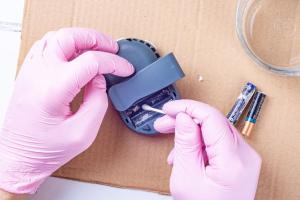Essential Guide to Safely Neutralizing and Cleaning Up Battery Acid

-
Quick Links:
- What is Battery Acid?
- Why Neutralize Battery Acid?
- Safety Precautions
- Materials Needed
- Step-by-Step Guide
- Disposal of Neutralized Acid
- Real-World Case Studies
- Expert Insights
- FAQs
What is Battery Acid?
Battery acid, commonly found in lead-acid batteries, is primarily composed of sulfuric acid (H₂SO₄). This corrosive substance is essential for the electrochemical reactions that take place within the battery, enabling it to store and release electrical energy. However, it poses significant hazards when spilled or improperly handled. Understanding the properties of battery acid is crucial for effective and safe cleanup.
Why Neutralize Battery Acid?
Neutralizing battery acid is essential for several reasons:
- Safety: Battery acid can cause severe burns and respiratory issues if inhaled or contacted with skin.
- Environmental Protection: Improper disposal can lead to soil and water contamination.
- Property Damage: Battery acid can corrode metals and damage surfaces, leading to costly repairs.
Safety Precautions
Before undertaking any cleanup operation, it is vital to follow safety precautions:
- Wear protective gear: gloves, goggles, and a mask.
- Work in a well-ventilated area to avoid inhaling fumes.
- Keep neutralizing agents away from children and pets.
Materials Needed
Gather the following materials for a successful cleanup:
- Sodium bicarbonate (baking soda)
- Water
- Plastic container for mixing
- Absorbent materials (sand, kitty litter)
- Trash bags for disposal
- Protective gear (gloves, goggles, mask)
Step-by-Step Guide
Follow these steps to safely neutralize and clean up battery acid:
Step 1: Assess the Situation
Evaluate the extent of the spill. If it’s minor, proceed with cleanup. For larger spills, consider seeking professional assistance.
Step 2: Prepare Your Neutralizing Solution
In a plastic container, mix 1 part baking soda with 3 parts water. This solution will help neutralize the acid.
Step 3: Apply the Neutralizing Solution
Carefully pour the solution over the spilled acid. Start from the edges and work toward the center to contain the spill.
Step 4: Allow it to React
Let the solution sit for about 15-30 minutes. This will allow the chemical reaction to neutralize the acid. You may notice fizzing as the reaction occurs.
Step 5: Clean Up the Neutralized Material
Once the reaction subsides, use absorbent materials to soak up the neutralized compound. Dispose of these materials in a trash bag.
Step 6: Final Cleanup
Wash the area with soap and water to remove any residues. Ensure that the area is safe for future use.
Disposal of Neutralized Acid
After neutralizing and cleaning the spill, dispose of the neutralized material correctly. Check local regulations for hazardous waste disposal, as improperly discarded materials can lead to environmental harm.
Real-World Case Studies
Several incidents highlight the importance of proper battery acid cleanup:
Case Study 1: Home Garage Spill
A homeowner experienced a minor battery acid spill while working on a vehicle. By following the proper neutralization methods, they avoided any injuries and limited property damage.
Case Study 2: Industrial Battery Facility
An industrial facility had a significant spill due to a leaking battery. The company implemented immediate safety protocols and engaged a hazardous materials team to ensure proper cleanup and disposal, adhering to environmental regulations.
Expert Insights
Experts recommend regularly checking batteries for leaks and maintaining proper ventilation in storage areas to minimize risks associated with battery acid.
According to Dr. Jane Smith, a chemist specializing in hazardous materials, "Understanding the chemical properties of battery acid and having the right materials on hand can make all the difference in a safe cleanup."
FAQs
1. What should I do if battery acid gets on my skin?
Immediately rinse the area with plenty of water for at least 15 minutes and seek medical attention if necessary.
2. Can I use vinegar to neutralize battery acid?
No, vinegar is acidic and can exacerbate the situation. Use baking soda instead.
3. How can I safely store batteries?
Store batteries in a cool, dry place away from direct sunlight and ensure they are in a leak-proof container.
4. Is it safe to dispose of neutralized battery acid in regular trash?
Check local regulations. Some areas may require special disposal methods for hazardous waste.
5. What protective gear do I need for battery acid cleanup?
Wear gloves, goggles, and a mask to protect against skin contact and inhalation of fumes.
6. How do I know if battery acid has spilled?
Signs include a strong sulfuric odor, discoloration around the battery, or visible liquid.
7. Can battery acid be recycled?
Yes, many recycling centers accept used batteries for proper recycling and disposal.
8. What are the long-term effects of battery acid exposure?
Long-term exposure can lead to respiratory issues, skin burns, and other health complications.
9. How can I prevent battery acid spills?
Regularly inspect your batteries for leaks and ensure they are stored securely.
10. What should I do if I inhale battery acid fumes?
Move to fresh air immediately and seek medical attention if you experience difficulty breathing or other symptoms.
Conclusion
Cleaning up battery acid is a task that should not be taken lightly. By following safety precautions and the steps outlined in this guide, you can neutralize and clean up battery acid safely and effectively. Always stay informed and prepared to ensure a safe environment for yourself and those around you.